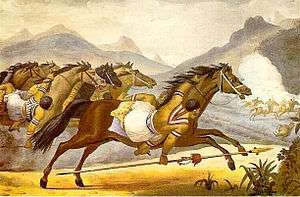Guaycuru peoples
|
Debret's deciption of the Guaycuru cavalry during an attack | |
| Regions with significant populations | |
|---|---|
|
| |
| Languages | |
| Guaicuruan languages | |
| Religion | |
| Animism | |
| Related ethnic groups | |
| Guarani |

Guaycuru or Guaykuru is a generic term for several ethnic groups indigenous to the Gran Chaco region of South America, speaking several related Mataco–Guaycuru languages.
At the time of the European conquest, the territory of the Guaycuru tribes extended into the present-day countries of Argentina (north of the Santa Fe Province), Bolivia, Paraguay, and Brazil (south of Corumbá).[1]
The name is written guaycurú or guaicurú in Spanish (plural guaycurúes or guaicurúes), and guaicuru in Portuguese (plural guaicurus). It was originally an offensive epithet given to some Mbayá tribes of Paraguay by the Guarani, meaning "savage" or "barbarian", which later got extended to the whole group. It has also been used in the past to include other tribes of the region, but is now restricted to those speaking a Mataco–Guaycuru language.
Divisions
The major extant branches of the Guaycuru are:[1]
The Mocoví, Toba, and Pilagá call themselves qom and appear to forma linguistic and ethnic continuum.[1] They have been placed together with the Abipón in the "Southern" division, while the Kadiweu are placed by themselves in a "Northern" division. The placement of the Payaguá in this classification is still controversial.[1]
Some authors, such as Quevedo, Hunt, Mason, Greenberg and Viegas Barros, have joined the Guaycuru and the Mataguay languages into a larger Mataco–Guaycuru language family, but it is not clear yet whether the similarities between the vocabularies of the two families are due to a common origin or to borrowing.[1]
Other Guaycuru groups have become extinguished over the last 500 years:
